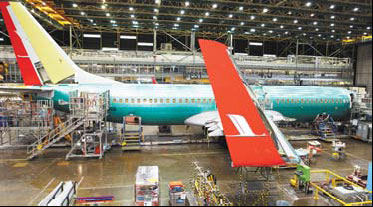Investment
Nation's air fleet to triple by 2030
By Wang Zhuoqiong (China Daily)
Updated: 2010-11-03 07:48
 |
Large Medium Small |
|
A Boeing Next Generation 737 jet for Shanghai Airlines sits on an assembly line at Boeing's manufacturing facility in Renton, Washington. Kevin P. Casey / Bloomberg |
Boeing expects big leap in aircraft demand over next two decades
BEIJING - China will need 4,330 new commercial airplanes valued at $480 billion over the next 20 years, with demand being driven by the country's burgeoning economy and soaring personal wealth, US aircraft manufacturer Boeing forecast.
Over that period the Chinese airplane fleet will triple in size, making it the largest market outside the United States, according to the company, which released its 2010 China market outlook on Tuesday in Beijing.
"Driven by the urbanization of China, the growth of its economy and ever-increasing personal wealth, China is one of the world's fastest growing and dynamic aviation markets," said Randy Tinseth, vice-president of marketing at Boeing Commercial Airplanes.
He expects the country's domestic passenger traffic to grow on average at an annual rate of 7.9 percent.
The majority of the new aircraft bought by Chinese carriers will be newer, more fuel-efficient single-aisle planes, or regional airliners, with total deliveries reaching 3,090, the company said. Boeing's single-aisle aircraft models include the 737 and the Next Generation 737-900.
Passengers nowadays want more convenient, frequent flights and only single-aisle aircraft can accommodate that demand, Tinseth said.
The single-aisle and intermediate twin-aisle market will account for 92 percent of China's total delivery in value.
About 60 twin-aisled wide-bodied 787 Dreamliners will be delivered to Chinese airlines next year, following a long delay caused by work to rectify various production problems.
Around 890 Boeing 777s will also be delivered.
A forecast by Airbus, the European aircraft manufacturer in February also painted a rosy picture of the Asia-Pacific market, which will acquire some 8,000 new passenger and cargo aircraft over the next 20 years. However, the company said demand is for larger aircraft.
The region is expected to take delivery of some 880 large aircraft, around 2,600 twin-aisle wide-body and 4,500 single-aisle aircraft, Airbus said.
The high proportion of larger aircraft reflects the concentration of populations around main urban centers, which generate high-density traffic on key intra-regional routes, in addition to capacity-constrained international destinations in Europe and North America, the company said.
Meanwhile, demand for single-aisle aircraft in the region is expected to continue rising in the coming years, driven by the growth of low-cost carriers and the opening of new routes between secondary destinations, especially in China, India and Southeast Asia.
With China's cargo markets leading the global industry, Boeing predicts that the country's air carriers will add about 330 freight airplanes by 2029, with the total freight fleet more than tripling in size.
Airbus predicts that around 340 new production freighters will be delivered to the region over 20 years. These will mainly be wide-body aircraft and will represent 40 percent of the expected global demand for new production freighters.
China Daily
